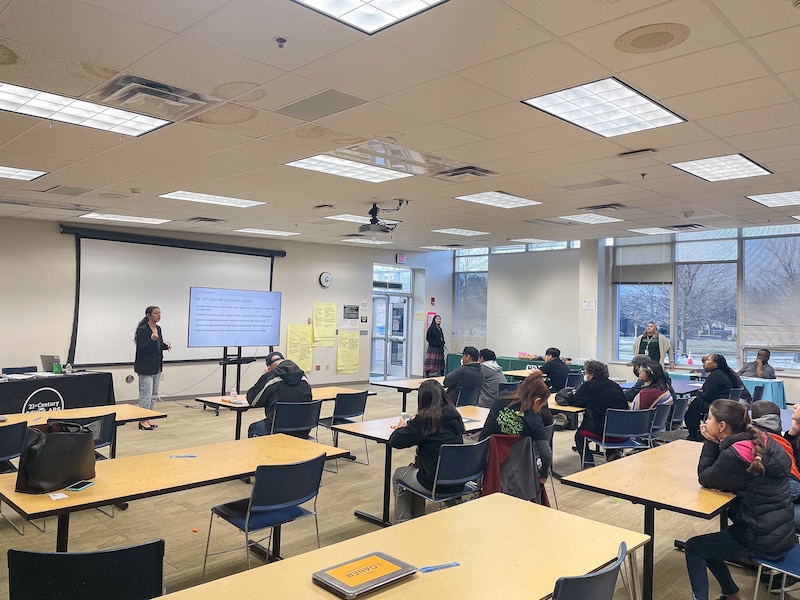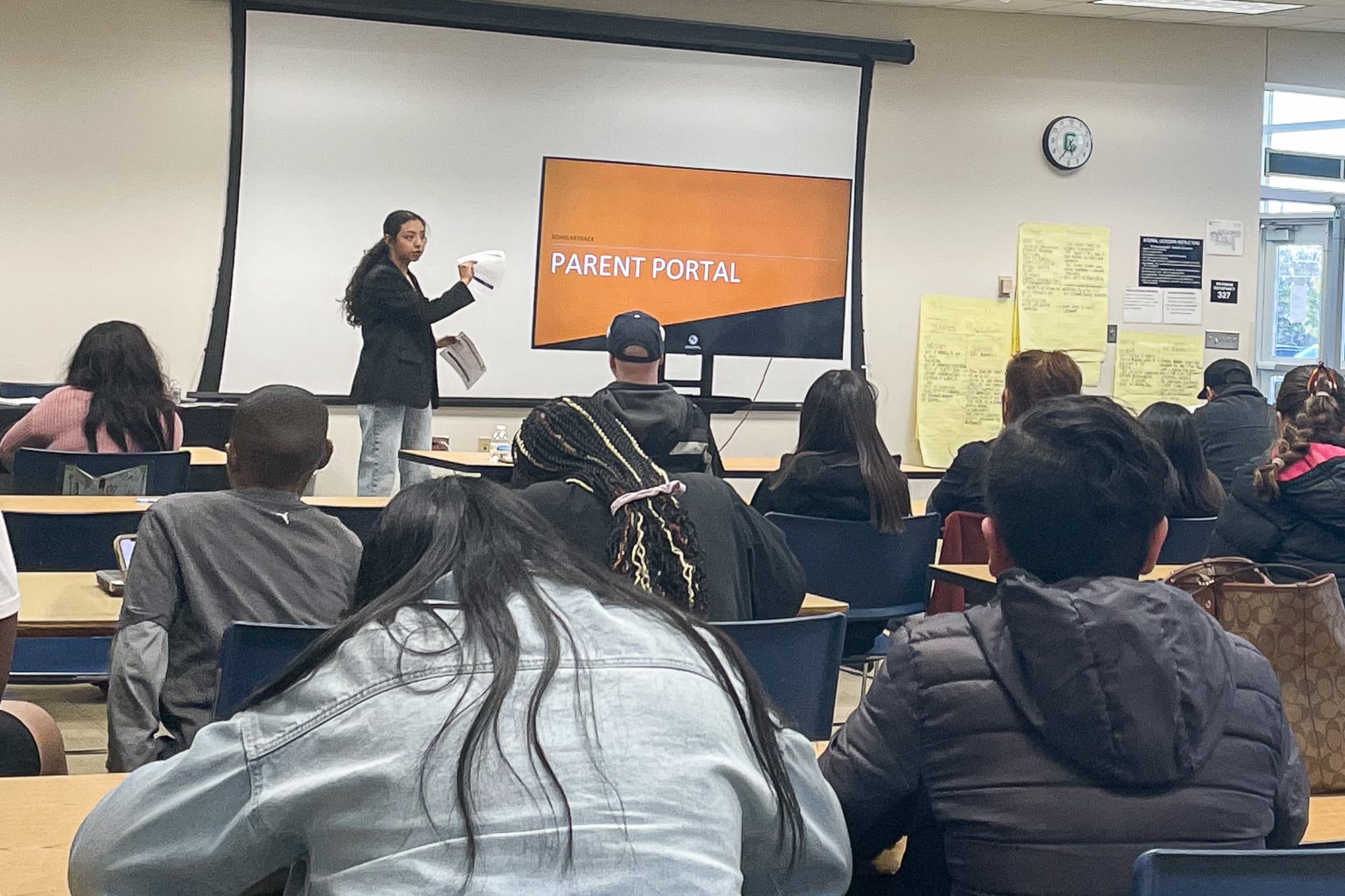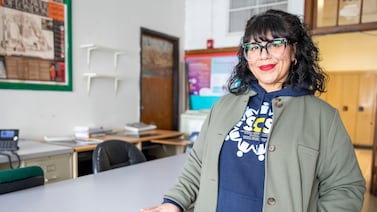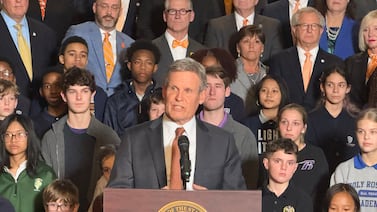Indiana’s 2023 legislative session is under way, and state legislators have introduced more than 100 new education bills and bills impacting schools and students. For the latest Indiana education news, sign up for Chalkbeat Indiana’s free newsletter here.
The tables were covered in Creston Middle School green, and topped with neat rows of snacks and cans of pop.
Another table was covered in brochures and paper applications. Laptops were scattered on tables around the room.
Because of the pandemic, it had been four years since an information session about 21st Century Scholars was in person at Creston Intermediate and Middle School, and organizers were doing all they could to entice families to attend the early March session and apply before their students reach high school and the deadline has passed.
The scholarship program offers up to the equivalent of four years tuition and regular fees at an in-state public university or college to students who meet income and residency eligibility, and follow requirements outlined in a scholar pledge.
Despite success with enrollees and its more than 30-year track record, the scholarship program has struggled to attract students to enroll in the program that has helped more than 50,000 Hoosiers earn college degrees. There’s also a no-exceptions deadline of June 30 after eighth grade for students to sign up.
But legislation at the statehouse aims to change that by auto-enrolling all eligible students into the scholarship program. This move is yet another effort to increase awareness of postsecondary options at a time when Indiana’s college-going rate is low, and higher education has the perception of being too expensive.
The bill, House Bill 1449, was approved by the Indiana House and has since advanced out of the Senate Education and Career Development Committee. But even with support from lawmakers, educators, and business leaders, the legislation still faces several votes before it could become law.
Talking to families about qualifying for scholarships
Berenice Tenorio travels Marion County, meeting with students and families to talk about postsecondary options as an outreach coordinator for the Indiana Commission for Higher Education.
“My goal isn’t that everyone goes to a four-year school,” she said.
She likened postsecondary options to a door, saying that students can avoid the door and asking questions about it if the path is dark. So, her goal is to light up the door and allow students to feel comfortable asking questions to help them make informed decisions about higher education.
One way she does that is through sessions for families about 21st Century Scholars, like the one at Creston.
The first challenge is making sure parents know about the scholarship and see it as worthwhile to attend the session she said. Once they are there, she said it’s about filling out the application to see if they qualify.
“I know that middle school students, they don’t see the price tag for college every single day like I do,” Tenorio said, adding that college can feel “so far away” to students and families.
In her presentation at Creston, she speaks in English and then in Spanish for each slide, going over what the scholarship is and isn’t and the requirements.
Yes, she tells people, the scholarship is usable for both public and private schools, but only covers up to the cost of tuition at public schools. Yes, students can take a gap year and still use the funds. Yes, students would need to complete the FAFSA as well as not drink alcohol before 21 and not do drugs.
Tenorio urges families who are unsure if they qualify to just apply, and tells them the income verification that’s part of the process may take a while.
Eventually, nearly three dozen people filled the room to listen and talk to Tenorio, who walked around to each family to answer questions and pick up applications.
Several families attended because the scholarship had become a family tradition after their older children enrolled. That was the case for Erika Rodriguenz, who said she learned about the program from a family member and thought it was a good opportunity for her middle school daughters.
She said she stresses to them the importance of studying now so they’ll be prepared for college down the road.
“The first time was hard, but this time not so much,” she said of the application.
Scholars see success, but graduation rates are low
Created in 1990, 21st Century Scholars can point to multiple successes.
More than 80% of students in the program enroll in college – that’s compared to 53% of all students statewide and 30% of students in the state from low-income backgrounds who are not in the program. And 75% of scholars stay in Indiana after graduating.
Despite these stats, the program has struggled to get the word out.
Although four in 10 Indiana students are eligible for 21st Century Scholars, only half of the eligible students apply. And a recent survey from the Indiana Department of Education shows that awareness of the scholarship is inconsistent: Just 64%of parents know about the program.

There’s also widespread pessimism about higher education’s price tag in general. Only 27% of parents think education beyond high school is affordable for Indiana students, the department’s survey found.
And not all of the data about 21st Century Scholars looks rosy. Just 37% of 21st Century Scholars graduate on time, compared to 44% of students statewide. However, their on-time graduation rate is still higher than the 27% for students from low-income backgrounds.
Indiana’s Commissioner for Higher Education Chris Lowery said the scholars’ graduation rate is something the commission is aware of and working on, in part by meeting with university and college presidents to share best practices and services they provide for scholars.
But that relatively low graduation rate for the program could harm efforts to expand it for the foreseeable future.
During an Indiana Commission for Higher Education presentation to the Senate Appropriations Committee about the state budget, lawmakers pressed Lowery about the program’s graduation rate. Some noted that students need to be ready for college when they attend, not just attend because it’s paid for.
That committee is where a Senate bill that was the same as the advancing House bill died earlier this legislative session. It’s also the House bill’s next step.
Auto-enrollment could make the program more effective
If the bill passes, the commission for higher education would work with IDOE to notify eligible students and their parents or guardians. To participate, students would still have to agree to the conditions of the scholar pledge, and they could opt out of the program at any time. Students would be identified before starting high school as they are now. And other key programming details wouldn’t change.
“It continues the momentum and removes barriers to the program,” Lowery told lawmakers during a Senate committee meeting this month.
In addition to support from the commission for higher education, the bill has backing from multiple education and economic groups including associations representing school principals and superintendents, the Indiana State Teachers Association, and the Indiana Chamber of Commerce.
Lowery added that if 21st Century Scholars enrolls students automatically, the commission would be able to shift program resources from a focus on scholarship enrollment to student success.
That possibility is what excites Tenorio, who would have more time to check in with students.
“Right now, the responsibility is on the parents to be all knowing, and this takes the pressure and responsibility off of them,” she said. “It allows us to say, ‘You’re already eligible, all you have to do is say yes and take advantage of this.’”
MJ Slaby oversees Chalkbeat Indiana’s coverage as bureau chief and covers higher education. Contact MJ at mslaby@chalkbeat.org. Chalkbeat Indiana partners with Open Campus on higher education coverage.






